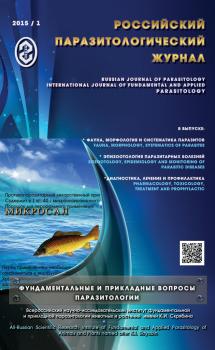Objective of research. The purpose of the study is the Confirmation of the diagnosis of trichinosis depends on many factors, among which is the sampling of muscle tissue from some of the most infested parts of the carcass, method of research and the equipment used. Materials and methods. The research material were samples of muscle tissue from experimentally T. spiralis infected rats. Was infected 18 white mongrel rats weighing 90-100g at a dose of 10 l/G. For the early diagnosis of trichinosis when the rats were killed with 6 to day 24 after infection. First investigated by the compressor method available and the most affected muscles: the diaphragm, masseter and chest muscles by increasing (x 25, 50, 100). Each term is made photomicrographs of larvae on the slices. Then the samples of the hindlimb muscle mass of 50 g was investigated by automated method of peptonize apparatus Gastros. At the end of the cycle of operation of the apparatus when microscopy was considered the quantity of larvae and their morphological development. Selected larvae 16 to 18 days of age have been infected mice (bioassay). After 35-36 days carcass mice were fully exposed topatolisfor the detection of Trichinella spp. Results and discussion. When peptonize automated method muscle tissue of rats infected with larvae of T. spiralis, found that larvae aged from 10 to 15 days after infection by the method are not detected. Trichinae isolated from 16-day-old, identified by microscopy, despite the lack of size of the larvae. The massive selection of Trichinella spp. begins with the 17th day after infection, when most of the larvae reaches invasionist. Non-encapsulated trichinae 16 days of age become invasive, which showed successful infection of white mice with larvae that are highlighted after peptonize. According to the results of a biosample main mass of larvae becomes infective to 19-20 days after infection. Thus, an automated method of peptonize muscle tissue easily diagnose the infection of animals with non-encapsulated larvae of Trichinella spp. that are difficult or sometimes impossible in compressor research. Diagnosis of trichinosis by automated method is most effective when the larvae of invasionist.
trichinosis, patolis apparatus Gastros, trichinoscopy, the species Trichinella spiralis, T. Pseudospiralis.
Введение
Основой профилактики трихинеллеза является обязательная ветеринарно-санитарная экспертиза мяса всех используемых в пищу туш свиней, кабанов, барсуков, медведей, других всеядных и плотоядных животных методами компрессорной трихинеллоскопии и пептолиза мышечной ткани зрелых личинок трихинелл. Подтверждение диагноза на трихинеллез зависит от многих факторов, в числе которых значится отбор образцов мышечной ткани от определенных наиболее инвазированных частей туши, метода исследования и используемого оборудования.
В число таких факторов также входит стадия развития паразита в течение биологического цикла до заражения нового хозяина. Единичные ювенильные личинки трихинелл появляются в миофибриллах мышечной ткани уже на 5-7-й дни после заражения, то есть с начала миграции по крови. Развитие личинок до инвазионной стадии возможно только в поперечно-полосатой мускулатуре, где они проходят сложный органогенез и увеличиваются в длину более чем в 10 раз. (Геллер Э.Р., Тимонов Е.В., 1969).Длительная миграция личинок ведет к накоплению их в мышцах к 25-30 суткам в зависимости от интенсивности инвазии.
Вопросу об инвазионности личинок трихинелл всегда уделялось большое внимание. Трихинеллы становятся инвазионными на 16-17-й день после заражения, когда у большинства личинок заканчивается органогенез (Лемишко П.М., 1947, 1948, 1949).
1. Berezantsev J.A. // “Wiadom.Parasitol.”. - 1969. - T. 15. - № 5-6. - S. 539-543.
2. Geller E.R., Pereverzev E.V. // Mat. sci. Conf. VOG - part 4. - M. -1965. - P. 42-46.
3. Geller E.R., E.V. Timonov // “Wiadom. Parasitol”. - 1969. - T. 15. - № 5-6. - P. 522-525.
4. Lemeshko P.M. // Veterinary Medicine. - 1947. - No. 5. - S. 37.
5. Lemeshko P.M. // Veterinaria. - M - 1948. - No. 11. - P. 36-37.
6. Lemeshko P.M., Proc. Kiev vet. in-TA. - 1949. - Vol. 9. - P. 88-95.
7. Silakova L.N. // Mat. Dokl. Vsesoyuz. Conf. on trichinosis humans and animals. - Vilnius. - 1972, Pp. 63-66.
8. Richels I. // „ Ztblt. F. Bact.Abt. I. Orig”. - 1955. - T. 163. - P. 46-84.





